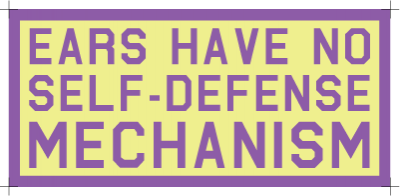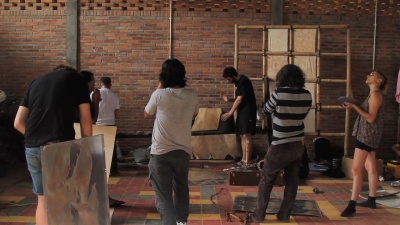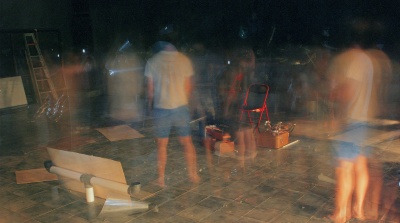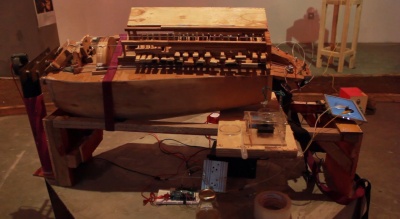Difference between revisions of "HLab14 Akustikologi - Yogyakarta"
(→Participants) |
|||
| (43 intermediate revisions by 4 users not shown) | |||
| Line 1: | Line 1: | ||
| − | <- back to main page of [[HackteriaLab 2014 - Yogyakarta]] | + | [[File:earshaveno.png|thumb|400px]] |
| + | |||
| + | <<<<- back to main page of [[HackteriaLab 2014 - Yogyakarta]] | ||
=== Akustikologi : Rehearsal === | === Akustikologi : Rehearsal === | ||
| + | |||
| + | [[File:Akustikologi Research-and-experiments-BPR.jpg|thumb|400px]] | ||
[[Akustikologi]] is a music project that provides a collaborative platform for artists, musicians, scientists and hackers to arrange and improvise musical compositions according to each own disciplines. This project challenges the participants to not use any kinds of electronic amplifiers for a collaborative compositions in order to recall our hearing sensitivity —as we are mechanosensitive beings— amidst our noise-polluted environment. | [[Akustikologi]] is a music project that provides a collaborative platform for artists, musicians, scientists and hackers to arrange and improvise musical compositions according to each own disciplines. This project challenges the participants to not use any kinds of electronic amplifiers for a collaborative compositions in order to recall our hearing sensitivity —as we are mechanosensitive beings— amidst our noise-polluted environment. | ||
| Line 15: | Line 19: | ||
'''19 - 21 April 2014, Bumi Pemuda Rahayu''' | '''19 - 21 April 2014, Bumi Pemuda Rahayu''' | ||
| − | Collaboration, Jamming, Discussions, Studioworks, Chillout, Hangout, Rehearsal, etc.. | + | Collaboration, Jamming, Discussions, Studioworks, Chillout, Hangout, Rehearsal, Instruments making, etc.. |
| − | ''' | + | '''23 April 2014, 19:00 - 22:00 Padepokan Seni Bagong Kussudiardja | Layang - Layang''' |
Collaboration Performance of the Participants | Collaboration Performance of the Participants | ||
| Line 23: | Line 27: | ||
=== Participants === | === Participants === | ||
| − | Jay Afrisando | + | Gisela Swaragita (ID) |
| + | |||
| + | James Nickols (AU) | ||
| + | |||
| + | Jay Afrisando (ID) | ||
| + | |||
| + | Lintang Raditya (ID) | ||
| + | |||
| + | Pia van Gelder (AU) | ||
| + | |||
| + | Rully Shabara (ID) | ||
| + | |||
| + | Tedi Nurmanto (ID) | ||
| + | |||
| + | Urban Schwegler (CH) | ||
| + | |||
| + | Wukir Suryadi (ID) | ||
| + | |||
| + | Yashas Shetty (IN) | ||
| + | |||
| + | Matt Baker (AU/NZ) | ||
| + | |||
| + | === The 1st discussion notes | 14 - 04 - 2014 === | ||
| + | |||
| + | '''Name | Background | Interest | Ideas''' | ||
| + | |||
| + | Rully | Musicians / Singer | Acoustic filters or effects for vocal | Designing acoustic filters / effects for vocal with pvc pipes and metals. | ||
| + | |||
| + | Tedi | Musicians / Instrument maker | Participatory musical performance | Conducting a participatory musical performance with the audiences. | ||
| + | |||
| + | Jay | Musicians / Poetry | Triggering other music instruments with his Saxophone | Saxophone triggering saluwang minang and kecapi jawa. | ||
| + | |||
| + | Lintang | Synthesizer Designer / Geek | Reverb spring and Mechanical synthesizer | Human surprise electrocution synthesizer . | ||
| + | |||
| + | Wukir | Musicians / Instrument maker | Bamboo | Making an Acoustic structures as a collaboration medium. | ||
| + | |||
| + | Soni | Musicians / Visual Artist | Collaborations | Making an Acoustic structures as a collaboration medium. | ||
| + | |||
| + | Pei | Sound Artist / Sound Activist | Soundscape, Field Recordings | Mimics particular sound object from the recorded soundscape in field research. | ||
| + | |||
| + | Yashas | Musician / Artist - Scientist | Instrument building | Making Instruments. | ||
| + | |||
| + | Matt Baker | Scientist / Rapper - Scientist | Sound Compressions | Lab gear / instruments Synthesizer and Pyro-mechanic synthesizer. | ||
| + | |||
| + | Theresa | Urban Activist | Participatory activities / interactivity | Found objects as musical instruments. | ||
| + | |||
| + | '''Material (as ideas)''' | ||
| + | |||
| + | - Thin metal sheet | ||
| + | |||
| + | - PVC PIPE / Plastic tube | ||
| + | |||
| + | - Plywood | ||
| + | |||
| + | - Computer Fan | ||
| + | |||
| + | - DC Motors | ||
| − | + | - Water Pump | |
| − | + | - Explosive Material ; Methane gas | |
| − | + | - Solenoid | |
| − | + | - Spring | |
| − | + | - Membran for Drums | |
| − | + | - Electronic Fan | |
| − | + | - Metal Wire | |
| − | Yashas Shetty | + | - etc. (please add if you have any ideas for the material list) |
| + | |||
| + | === Performance === | ||
| + | Download and listen to the composition from here [http://www.mediafire.com/listen/dkgiguuno4ui6oq/Akustikologi_Komposisi_123.wav] | ||
| + | [[File:Akustikologi Budi-Laksono.jpg|thumb|400px]] | ||
| + | |||
| + | === Exhibitions === | ||
| + | |||
| + | |||
| + | '''Hurdi Gurdi Grade''' | ||
| + | [[File:HLab14_HurdiGurdiGrade.jpg|thumb|400px]] | ||
| + | Live installation comprising microscope, sensors, LCD Screens, micro controllers, DC Motor, tray and Hurdi Gurdi | ||
| + | |||
| + | By: [http://hackteria.org/wiki/HackteriaLab_2014_Participants#Yashas_Shetty Yashas Shetty], Wukir Suryadi, Lintang Praditya, [http://hackteria.org/wiki/HackteriaLab_2014_Participants#Gisela_Swaragita Gisela Swaragita], [http://hackteria.org/wiki/HackteriaLab_2014_Participants#Shreyasi_Kar Shreyasi Kar], [http://hackteria.org/wiki/HackteriaLab_2014_Participants#Muhammad_Hidayat_a.k.a_Julian_Abraham_a.k.a_Togar Julian Abraham aka Togar] | ||
| + | |||
| + | Description: It is a bioacoustic instrument that looks the interface between non-humans and human cultural artifacts. This work is a continuation of the akustikologi project. Akustikologi itself is a platform for artists, designer, hackers, makers, musicians, and scientists to work on acoustic technology and related issues. The exploration of sonic possibilities has always been an integral part of hackteria and hackterialab, and akustikologi is a continuation of that tradition. | ||
| + | |||
| + | Future plans: We hope that the [Akustikologi] network will extend with more collaborators and partners. | ||
| + | |||
| + | Keywords: Bio Acoustic, tardigrade, akustikologi, collaboration, interface | ||
=== Suggestions, ideas, or thingys for the future === | === Suggestions, ideas, or thingys for the future === | ||
| Line 58: | Line 137: | ||
8. Ask Stelarc opinion about Wukir going to implant the guitar bamboo on his left hand ? (Y U NO HERE?) | 8. Ask Stelarc opinion about Wukir going to implant the guitar bamboo on his left hand ? (Y U NO HERE?) | ||
| + | |||
| + | 9. using non-electro amplified built instrument/tool to mimick particular sound object from the recorded soundscape in field research. In another word, situating the known to the unknown and build an acoustic landmark by performing the translation of it /pei . | ||
| + | |||
| + | 10. not sure how is the difference in acoustic between the rehearsal and performance space, of course can use the space(s) itself as amplified or resonator~ | ||
| + | |||
| + | 11. we could try to install giant gramophone cylinder for the performance stage, it can be made from wood, cardboard, or plastics. But do we need to amplify it? /togi. | ||
| + | |||
| + | 12. making a musical instruments? | ||
| + | |||
| + | |||
| + | == Summary / Blurb == | ||
| + | |||
| + | Togar asked me (phatmattbaker) to write some words about the project, in whatever form I wanted. I wrote this and sent it to him. Am putting it here for completeness. | ||
| + | |||
| + | |||
| + | Sound is ultimately a very physical medium: from the vibrations you can feel in front of a speaker box, to the way we generate sounds. The modern era is resplendent with noise, from car stereos, to the screech of motorbikes. Historically volume was an epic endeavour, organs took serious effort to build, and were the loudest instruments of their day, but now loudness is easily achieved, and everywhere, through cheap and ubiquitous amplification circuitry. | ||
| + | |||
| + | Akoustikologi seeks to address sound as a collaboration between international scientists and artists present at HackteriaLab 2014 to generate music using only organic, unamplified sounds. This project uses the physics of sound, and the physicality of soundwaves to direct the audience’s awareness to what sounds can be generated by a group of people and their environment. | ||
| + | |||
| + | The speed of sound is 340 metres per second, which is faster than most humans are able to travel in their lifetime, but, as a result of this fact, most frequencies audible by humans have wavelengths around the human length scale. For example, a 30 Hz bass frequency has a wavelength of 11 metres, a concert pitch 440 Hz has a wavelength of just under a metre. Thus the physical lengths of the sounds around us are innately linked to our size. Were we the size of elephants, or alternatively rabbits, we would no doubt hear things differently, and create different music for ourselves. Akoustikologi explores the dependence on human biology, both to create it and to hear it, that underlies music. | ||
| + | |||
| + | This was my first experience in a collaboration between physicists, mathematicians, musicians, and artists, across myriad cultural backgrounds. We departed for the BPR retreat with a truck full of tools and a couple of instruments, and quickly began assembling instruments from sheet metal, bamboo, wood, and flax. With the engineering out of the way, we improvised and revised a 5-part composition incorporating the differences in our cultural and educational approaches. This piece begins with a quiet reed flute introduction, before moving through a cacophony of steel, the call, our improv vibraphone, and returning to wind instrumentals and vocals before a light percussive finish. It was a real pleasure working with all the artists, local coordinators, and attendees at HackteriaLab2014 to bring this acoustic piece to life, ultimately over a short but intense period of activity. It is rare to get a break from the noise in our lives to control the sounds we wish to create, and Togar facilitated this opportunity for us all. | ||
| + | |||
| + | == Further Links == | ||
| + | |||
| + | http://en.wikipedia.org/wiki/List_of_silent_musical_compositions | ||
| + | |||
| + | http://en.wikipedia.org/wiki/4%E2%80%B233%E2%80%B3 | ||
Latest revision as of 12:16, 11 May 2015
<<<<- back to main page of HackteriaLab 2014 - Yogyakarta
Contents
Akustikologi : Rehearsal
Akustikologi is a music project that provides a collaborative platform for artists, musicians, scientists and hackers to arrange and improvise musical compositions according to each own disciplines. This project challenges the participants to not use any kinds of electronic amplifiers for a collaborative compositions in order to recall our hearing sensitivity —as we are mechanosensitive beings— amidst our noise-polluted environment.
Backgrounds
Noise pollution, is the changes of the structure (compositions) of our environment due to excessive noise, affecting the life quality of living beings surround it. Sound pollution can be caused by natural phenomena or human activity. Rapid technology development and the population growth is instantly making noise pollution is generated by human daily activity. Indirectly, sound pollution can affecting physical and psychological health of us humans, such as sleep disturbance, stress, hypertension, and hearing loss. The last symptoms defined as Noise Induced Hearing Loss (NIHL).
NIHL commonly happened due to damaged or death of the hair cells on the basilar membrane (the base for the sensory cells of hearing). Unlike bird and amphibian, damage or death of these hair cells is permanent in mammals (humans included). Until now, there are no technology that can regrow these hair cells. For that, the only way to keep our hearing sensitivity is to recognize the sounds around us and know its power limit.
Schedules, Venues
19 - 21 April 2014, Bumi Pemuda Rahayu
Collaboration, Jamming, Discussions, Studioworks, Chillout, Hangout, Rehearsal, Instruments making, etc..
23 April 2014, 19:00 - 22:00 Padepokan Seni Bagong Kussudiardja | Layang - Layang
Collaboration Performance of the Participants
Participants
Gisela Swaragita (ID)
James Nickols (AU)
Jay Afrisando (ID)
Lintang Raditya (ID)
Pia van Gelder (AU)
Rully Shabara (ID)
Tedi Nurmanto (ID)
Urban Schwegler (CH)
Wukir Suryadi (ID)
Yashas Shetty (IN)
Matt Baker (AU/NZ)
The 1st discussion notes | 14 - 04 - 2014
Name | Background | Interest | Ideas
Rully | Musicians / Singer | Acoustic filters or effects for vocal | Designing acoustic filters / effects for vocal with pvc pipes and metals.
Tedi | Musicians / Instrument maker | Participatory musical performance | Conducting a participatory musical performance with the audiences.
Jay | Musicians / Poetry | Triggering other music instruments with his Saxophone | Saxophone triggering saluwang minang and kecapi jawa.
Lintang | Synthesizer Designer / Geek | Reverb spring and Mechanical synthesizer | Human surprise electrocution synthesizer .
Wukir | Musicians / Instrument maker | Bamboo | Making an Acoustic structures as a collaboration medium.
Soni | Musicians / Visual Artist | Collaborations | Making an Acoustic structures as a collaboration medium.
Pei | Sound Artist / Sound Activist | Soundscape, Field Recordings | Mimics particular sound object from the recorded soundscape in field research.
Yashas | Musician / Artist - Scientist | Instrument building | Making Instruments.
Matt Baker | Scientist / Rapper - Scientist | Sound Compressions | Lab gear / instruments Synthesizer and Pyro-mechanic synthesizer.
Theresa | Urban Activist | Participatory activities / interactivity | Found objects as musical instruments.
Material (as ideas)
- Thin metal sheet
- PVC PIPE / Plastic tube
- Plywood
- Computer Fan
- DC Motors
- Water Pump
- Explosive Material ; Methane gas
- Solenoid
- Spring
- Membran for Drums
- Electronic Fan
- Metal Wire
- etc. (please add if you have any ideas for the material list)
Performance
Download and listen to the composition from here [1]
Exhibitions
Hurdi Gurdi Grade
Live installation comprising microscope, sensors, LCD Screens, micro controllers, DC Motor, tray and Hurdi Gurdi
By: Yashas Shetty, Wukir Suryadi, Lintang Praditya, Gisela Swaragita, Shreyasi Kar, Julian Abraham aka Togar
Description: It is a bioacoustic instrument that looks the interface between non-humans and human cultural artifacts. This work is a continuation of the akustikologi project. Akustikologi itself is a platform for artists, designer, hackers, makers, musicians, and scientists to work on acoustic technology and related issues. The exploration of sonic possibilities has always been an integral part of hackteria and hackterialab, and akustikologi is a continuation of that tradition.
Future plans: We hope that the [Akustikologi] network will extend with more collaborators and partners.
Keywords: Bio Acoustic, tardigrade, akustikologi, collaboration, interface
Suggestions, ideas, or thingys for the future
1. Make DIY version of sound level meter ? (Need a good filter for calibration, display, and battery powered gadget thingy)
2. Make DIY earplug ? (Need to find a fine, flexible, versatile material for customize DIY earplug, so it can fit on everyones ears)
3. Make DIY analog records player ? (Don't know why we need it, but it's cool to have one, or to make one)
4. Make DIY parabolic microphone ? (Cool device to have when we go out to the forest for cricket hunting, cicadas hunting, bird watching, or eavesdropping other peoples conversations)
5. Make DIY hydrophone ? (This is what all CEO's from every mobile phone company ask to their engineer : " can you make it water-proof?")
6. Change our ears into fish ears or amphibian ears ? (at some point, we don't need to worried about damaging our ears)
7. Release records for each collaborations project ? (imagine image)
8. Ask Stelarc opinion about Wukir going to implant the guitar bamboo on his left hand ? (Y U NO HERE?)
9. using non-electro amplified built instrument/tool to mimick particular sound object from the recorded soundscape in field research. In another word, situating the known to the unknown and build an acoustic landmark by performing the translation of it /pei .
10. not sure how is the difference in acoustic between the rehearsal and performance space, of course can use the space(s) itself as amplified or resonator~
11. we could try to install giant gramophone cylinder for the performance stage, it can be made from wood, cardboard, or plastics. But do we need to amplify it? /togi.
12. making a musical instruments?
Summary / Blurb
Togar asked me (phatmattbaker) to write some words about the project, in whatever form I wanted. I wrote this and sent it to him. Am putting it here for completeness.
Sound is ultimately a very physical medium: from the vibrations you can feel in front of a speaker box, to the way we generate sounds. The modern era is resplendent with noise, from car stereos, to the screech of motorbikes. Historically volume was an epic endeavour, organs took serious effort to build, and were the loudest instruments of their day, but now loudness is easily achieved, and everywhere, through cheap and ubiquitous amplification circuitry.
Akoustikologi seeks to address sound as a collaboration between international scientists and artists present at HackteriaLab 2014 to generate music using only organic, unamplified sounds. This project uses the physics of sound, and the physicality of soundwaves to direct the audience’s awareness to what sounds can be generated by a group of people and their environment.
The speed of sound is 340 metres per second, which is faster than most humans are able to travel in their lifetime, but, as a result of this fact, most frequencies audible by humans have wavelengths around the human length scale. For example, a 30 Hz bass frequency has a wavelength of 11 metres, a concert pitch 440 Hz has a wavelength of just under a metre. Thus the physical lengths of the sounds around us are innately linked to our size. Were we the size of elephants, or alternatively rabbits, we would no doubt hear things differently, and create different music for ourselves. Akoustikologi explores the dependence on human biology, both to create it and to hear it, that underlies music.
This was my first experience in a collaboration between physicists, mathematicians, musicians, and artists, across myriad cultural backgrounds. We departed for the BPR retreat with a truck full of tools and a couple of instruments, and quickly began assembling instruments from sheet metal, bamboo, wood, and flax. With the engineering out of the way, we improvised and revised a 5-part composition incorporating the differences in our cultural and educational approaches. This piece begins with a quiet reed flute introduction, before moving through a cacophony of steel, the call, our improv vibraphone, and returning to wind instrumentals and vocals before a light percussive finish. It was a real pleasure working with all the artists, local coordinators, and attendees at HackteriaLab2014 to bring this acoustic piece to life, ultimately over a short but intense period of activity. It is rare to get a break from the noise in our lives to control the sounds we wish to create, and Togar facilitated this opportunity for us all.
Further Links
http://en.wikipedia.org/wiki/List_of_silent_musical_compositions



